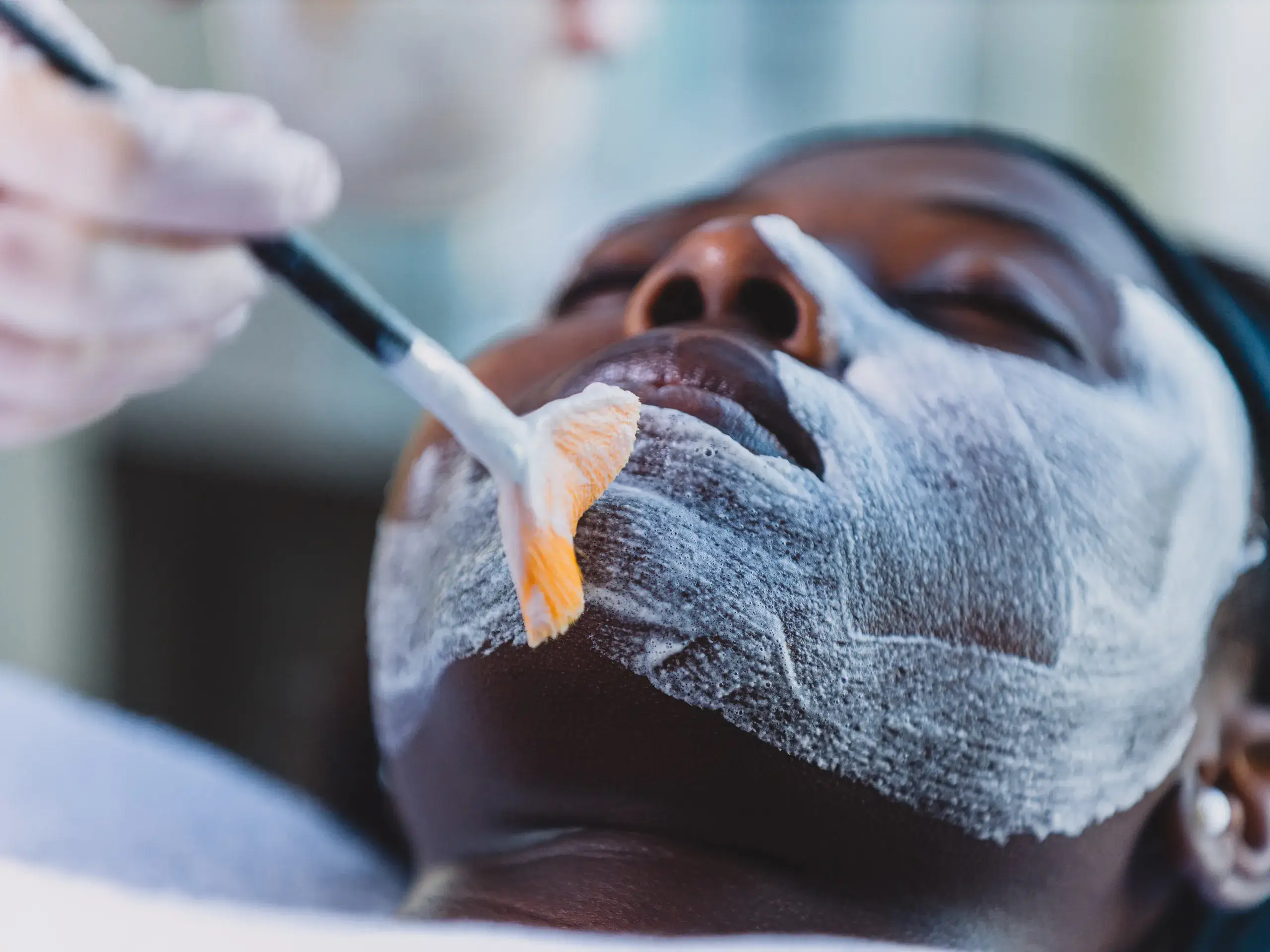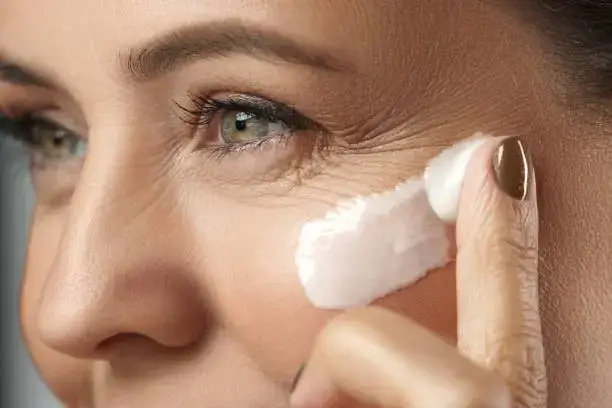The 5 Best Chemical Peels for Hyperpigmentation on Black Skin: A Comprehensive Guide
Hyperpigmentation is a common skin condition that affects people of all skin types and ages, including those with black or dark skin tones. It mainly occurs because the skin produces excess melanin, leading to dark spots, patches, or uneven skin tone.
While several treatments are available, chemical peels have gained popularity for their effectiveness in addressing hyperpigmentation.
This they do by exfoliating the skin’s outer layers and promoting cellular turnover. However, not all chemical peels are created equal, and when it comes to black skin, it’s essential to consider specific factors to ensure safe and optimal results.
This blog post will explore the best chemical peels specifically designed for hyperpigmentation on black skin. Ultimately, you will learn how to choose the right chemical peel, the different types of chemical peels suitable for black skin, and their respective benefits.
Let’s dive in!
Chemical Peels for Hyperpigmentation on Black Skin
Understanding black skin and hyperpigmentation

Understanding the unique nature of black skin before underlying treatment for hyperpigmentation on black skin is essential. Black skin contains higher levels of melanin compared to other skin types. Melanin is a pigment responsible for skin color, hair, and eyes.
Black skin often has a smoother and more supple texture than other skin types. The increased presence of natural oils helps maintain skin hydration and reduces the appearance of fine lines and wrinkles.
These natural oils tend to have a higher production in black skin, which can lead to concerns such as oily skin, acne, and enlarged pores.
However, black skin is more prone to hyperpigmentation caused by the overproduction of melanin in some areas of the skin, which are effective for protecting the skin against ultraviolet (UV) radiation.
This hyperpigmentation occurs due to acne, injuries, hormonal changes, or inflammation. Treating hyperpigmentation in black skin requires special considerations to ensure safe and effective results.
Understanding these unique characteristics of black skin is essential for developing tailored treatments for hyperpigmentation on black skin.
It’s essential to consult with a dermatologist or skincare professional who specializes in treating black skin to receive personalized advice and recommendations.
What are Chemical Peels?
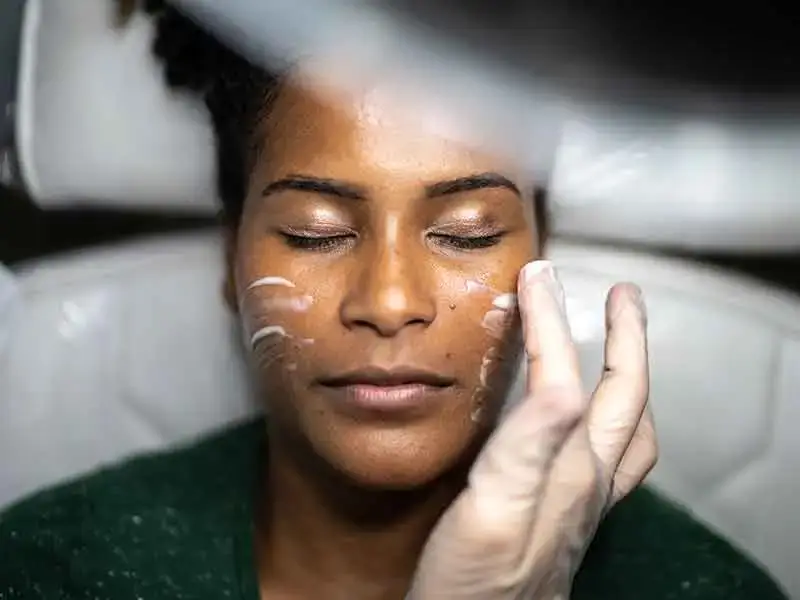
A chemical peel is a cosmetic procedure performed by trained professionals to improve the appearance of the skin by applying a chemical solution to the skin’s surface.
The solution causes controlled exfoliation and peeling of the outer layers of the skin, revealing fresher, smoother, and more youthful-looking skin underneath.
It addresses various skin concerns, including hyperpigmentation, acne, fine lines and wrinkles, uneven skin tone, sun damage, and texture irregularities.
They work by accelerating the skin’s natural exfoliation process and stimulating collagen production, rejuvenating and improving overall skin appearance.
Chemical peels can vary in strength, ranging from superficial to medium and deep peels with varying levels of intensity and downtime.
The type and strength of the peel recommended by a dermatologist or skincare professional will be determined based on the individual’s skin type, concerns, and desired outcome.
Factors to Consider for Choosing the Right Chemical Peel on black skin
To avoid any adverse side effects, including post-inflammatory hyperpigmentation, some factors should be considered while selecting a chemical peel for hyperpigmentation on black skin. The following are essential factors to bear in mind:
#1. Skin Type and Sensitivity
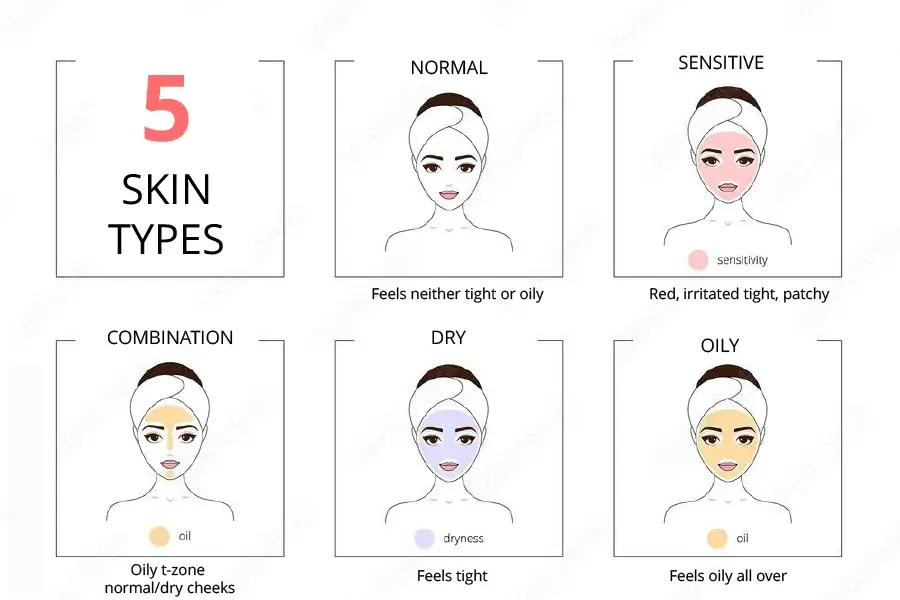
The precise skin type of black skin can range from oily to dry to combination. When selecting a chemical peel, it’s crucial to consider your skin type and any current skin sensitivities.
Some peels are better suited for particular skin types, and choosing the right peel might help reduce the risk of adverse reactions or complications.
#2. Hyperpigmentation Concerns
If your primary concern is hyperpigmentation, choosing a chemical peel specifically formulated to tackle the problem is critical. Look for peels that treat uneven skin tone, dark patches, or hyperpigmentation.
#3. Depth of Peel
Consider the depth of the peel you’re comfortable with. Superficial peels are generally well-tolerated and have minimal recovery time, making them suitable for addressing mild hyperpigmentation and maintaining general skin health.
However, a medium-depth peel may be more beneficial for stubborn problems or more substantial hyperpigmentation, even if it could necessitate a few days of recovery.
#4. Professional Guidance
Consulting a dermatologist or skincare expert specializing in dark skin is strongly advised. They can evaluate your unique needs, skin type, and sensitivity before recommending the best chemical peel.
Their knowledge will guarantee that the peel suits your skin and help you navigate the healing process.
#5. Pre and Post-Peel Care
Consider the pre and post-peel care instructions associated with the chemical peel. Proper skin preparation before the peel can enhance the treatment’s effectiveness and minimize the risk of complications.
Additionally, post-peel care is crucial for optimal healing and results. Ensure you are willing and able to follow the recommended pre and post-peel care instructions before choosing.
#6. Patch Testing
Conducting a patch test on a small area of your skin before applying a chemical peel to your whole face to check for any adverse reactions or sensitivity is crucial. This step helps ensure the peel suits your skin and minimizes the risk of a severe reaction.
Best Chemical Peels for Hyperpigmentation on Black Skin
There are several types of chemical peels for hyperpigmentation on black skin; they include:
a) Glycolic Acid Peel
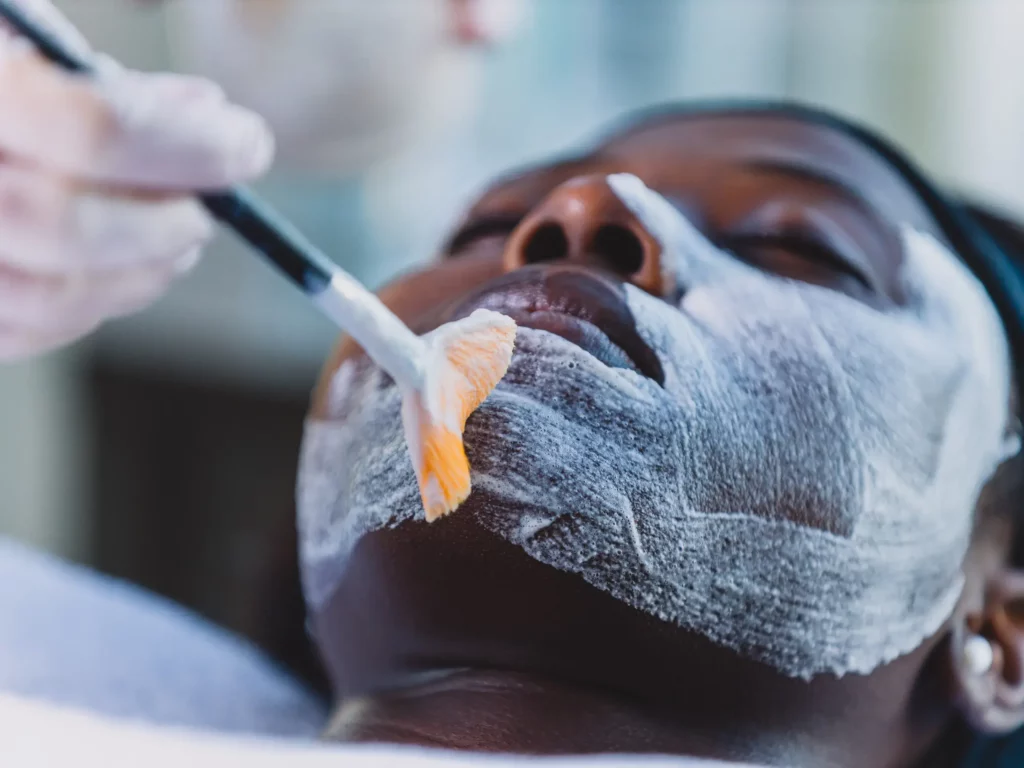
Glycolic acid peel is a popular chemical peel for addressing hyperpigmentation, including dark spots, melasma, and post-inflammatory hyperpigmentation (PIH) on black skin.
This superficial peel derived from sugarcane effectively targets hyperpigmentation by exfoliating the top layers of the skin, promoting cellular turnover, reducing the appearance of pigmentation irregularities, and stimulating collagen production.
It improves overall skin texture by smoothing out roughness, fine lines, and wrinkles, brightening, and reducing dark spots. It helps to unclog pores, removes dead skin cells, and improves the absorption of skincare products that follow the treatment.
It’s advisable, to begin with lower concentrations and gradually increase the strength over time when starting with glycolic acid peels. This approach allows the skin to acclimate to the peel and reduces the risk of excessive irritation or adverse reactions.
b) Lactic Acid Peel
A lactic acid peel is another excellent option for addressing hyperpigmentation on black skin while maintaining hydration. Compared to glycolic acid, it is a gentle alpha hydroxy acid (AHA) that can effectively target hyperpigmentation on black skin, which is more prone to skin sensitivity.
Regular use of lactic acid peels can help improve skin texture, soften roughness, and reduce the appearance of fine lines and wrinkles without causing excessive irritations.
This gentle peel derived from milk helps even out skin tone for a more youthful complexion, diminishes hyperpigmentation, and enhances skin hydration by promoting collagen production and increasing skin cell turnover.
c) Mandelic Acid Peel
Mandelic acid is an alpha hydroxy acid (AHA) derived from bitter almonds, found to be effective in reducing hyperpigmentation, including dark spots, melasma, and post-inflammatory hyperpigmentation (PIH).
It has a larger molecular size than other AHAs, such as glycolic acid, making it gentler on the skin. Mandelic acid exfoliates the outermost layer of the skin, removing dead skin cells and promoting a brighter, more radiant complexion suitable for sensitive black skin.
Mandelic acid has natural antibacterial properties, effectively targeting acne and reducing breakouts. It can help unclog pores, regulate sebum production, and improve skin clarity and texture.
d) Salicylic Acid Peel
Salicylic acid is a beta-hydroxy acid (BHA) commonly derived from willow bark. It is particularly beneficial for individuals with oily or acne-prone skin because of its ability to dissolve excess oil and sebum on the skin.
It penetrates the pores deeply, exfoliates the skin, and helps to unclog pores, reducing the occurrence of acne breakouts. By targeting acne, a salicylic acid peel can also help minimize post-inflammatory hyperpigmentation (PIH) caused by acne lesions and hyperpigmentation on black skin.
Salicylic acid peels can vary in strength and intensity. Depending on the concentration and depth of the peel, you may experience mild redness, flaking, or dryness afterward.
It’s essential to follow the post-peel care instructions provided by your skincare professional to ensure proper healing and minimize potential side effects.
e) Trichloroacetic acid (TCA) peels
TCA peels are stronger chemical peels that penetrate deeper into the skin. They can effectively target moderate to severe hyperpigmentation, including melasma.
TCA peels work by exfoliating the outer layer of the skin and promoting collagen production, leading to a more even skin tone.
Preparing for a Chemical Peel: Pre-peel skin preparation tips
It’s essential to thoroughly prepare your skin before a chemical peel to get the best results and reduce potential adverse effects. Consider the following pre-peel skin preparation tips:
- Consult with a Skincare Expert for dark skin.
- Stop Using Exfoliating Products such as scrubs and other chemical exfoliants for at least a week before the peel. It lessens the likelihood of skin irritation and overly sensitive skin during the peel.
- In the weeks before the chemical peel, limit your exposure to the sun. Wear protective clothing and a broad-spectrum sunscreen with a high SPF. Skin that has been sunburned or tanned is more prone to difficulties during the peel.
- Avoid waxing or depilatory creams for at least one week before the peel. These hair removal techniques can make your skin more sensitive, making the peel more painful.
- Let your skincare expert know if you use any medications or have allergies. Before the peel, some drugs, such as retinoids, may need to be stopped. Give any known allergies or sensitivities a heads-up so the right peel solution can be chosen.
- In the days before the peel, moisturize frequently to moisturize your skin. Hydrated skin lowers dryness or flakiness after a peel and supports healing.
- Comply with Pre-Peel guidelines provided by your skincare expert relevant to your skin type and the chemical peel used.
Remember that these pointers are only general ideas; it is crucial to speak with a skincare expert for tailored guidance and suggestions based on your skin’s requirements.
General Post-Peel Care and Maintenance Tips
After a chemical peel, optimal healing, enhancing results, and maintaining the health of your skin depend on post-peel care. Here is some vital advice on post-peel care to take into account:
- Follow Your Skincare Professional’s guidelines strictly to encourage proper recovery and reduce difficulties; it’s essential to adhere to them carefully.
- Use a soft, non-abrasive cleanser to cleanse your skin after a chemical peel. Avoid abrasive or harsh scrubs, cleansers with active chemicals, or excessive rubbing because these might aggravate the skin even more.
- Keep your skin moisturized by consistently applying moisturizer for your skin type. Moisturizing promotes healing, keeps skin hydrated, and calms the skin.
- Use a high SPF broad-spectrum sunscreen to shield your skin from the sun’s harmful rays. Sunlight can exacerbate hyperpigmentation and slow the healing process.
- Prevent using harsh skincare products for a few days or as directed by your skincare specialist.6. Let your skin recover and shed normally after the peel. Avoid picking, scraping, or exfoliating the peeling skin because doing so may result in scars or pigmentation problems.
- After your skin has fully recovered, maintain a healthy skincare routine. Your skincare specialist could suggest particular products or treatments that keep the peel’s effects at their best, depending on your skin’s demands.
- Make any recommended follow-up consultations with your skincare expert to track the development of your skin, resolve any issues, and decide whether additional treatments or modifications are required.
The type and degree of the chemical peel you receive will determine the post-peel care regimen, so keep that in mind.
Before you go
In pursuing radiant, even-toned skin, chemical peels have emerged as an effective treatment option for hyperpigmentation on black skin. By choosing the right chemical peel tailored to your specific skin needs, you can reduce the appearance of dark spots and achieve a more vibrant complexion.
However, before deciding on the best chemical peel for hyperpigmentation on black skin, it’s advisable to consult with a skincare professional or dermatologist who can evaluate your skin and recommend the best approach based on your specific needs and goals.
Note that this blog post is for informational purposes only and should not substitute professional medical advice.
Glow right!

